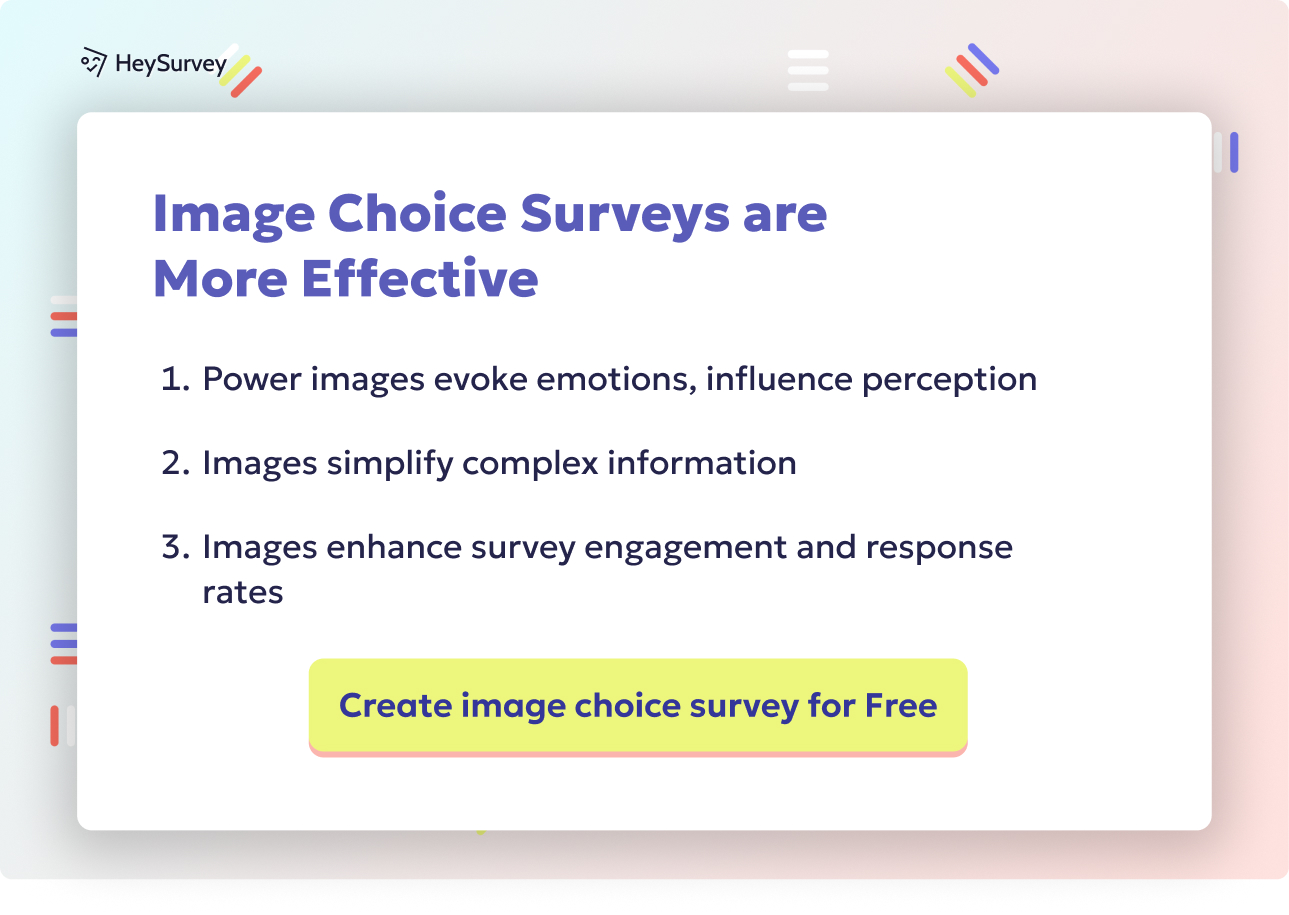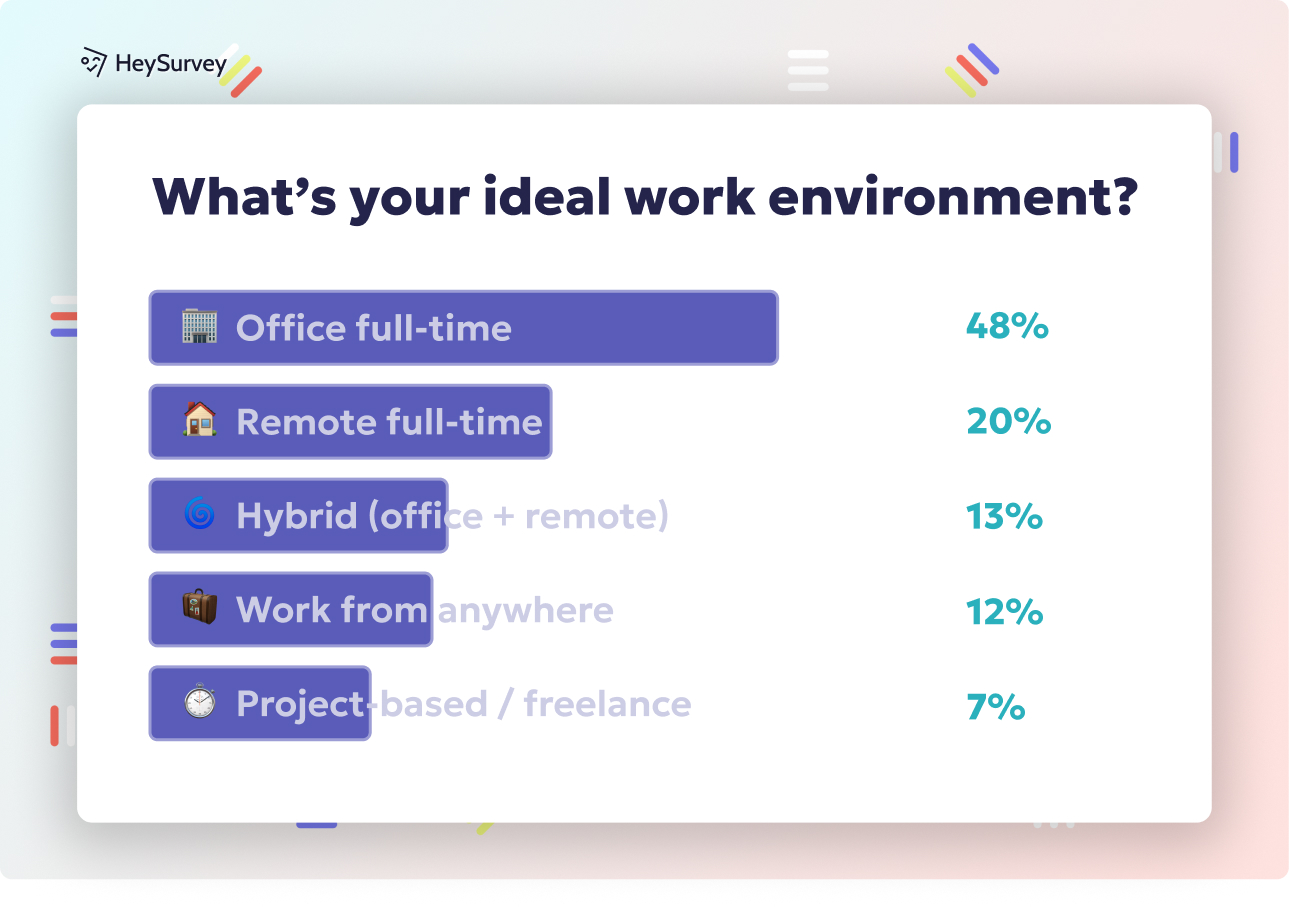29 Essential Bullying Survey Questions to Improve Safety
Explore 30+ effective bullying survey questions with sample queries across student, workplace, cyberbullying, and more to improve safety and trust.
Bullying is everywhere—on playgrounds, in the staff lounge, and across social feeds. Over one in five students report being bullied each year, and over 60 million workers globally say they’ve experienced workplace intimidation. These numbers are more than dots on a graph—they fuel an urgent need to listen, understand, and respond. That’s where thoughtful bullying survey questions come in. Surveys measure prevalence, expose hidden trends, fuel prevention programs, and keep organizations compliant with laws like the Safe Schools Act and OSHA. The perfect time to use them? Think school year kick-off, after a bullying spike, annual climate reviews, or as part of onboarding—whenever you want the clearest picture of what’s really happening.
Student Bullying Experience Survey
Peeling back the curtain on bullying in schools starts with a student bullying questionnaire. These surveys dig into authentic, real-time stories from students across grade levels. Whether you’re a principal, counselor, or district leader, knowing when and how often kids are bullied (and how they feel about it) sets the stage for impactful change.
Why & When to Use
You should break out the victim survey before launching any anti-bullying initiative. It’s your baseline, letting you measure whether new tactics really put a dent in the data.
Add an annual or even semester follow-up. This way, you spot spikes or declines. When a sudden cluster of reports hits your inbox, cycle in the student bullying experience survey to see what’s changed and what’s needed.
Timing tips:
- At the beginning of the school year.
- After a high-profile incident hits the rumor mill.
- Before and after new programs (to track what’s working).
Sample Questions
In the past four weeks, how often have you been mocked, teased, or called names at school?
Where do most bullying incidents you experience occur (classroom, hallway, bus, online, other)?
What type of bullying have you faced most frequently (physical, verbal, social exclusion, cyber)?
Did you report the most recent incident to an adult? Why or why not?
How safe do you feel at school on a typical day? (1 = Not safe at all, 5 = Very safe)
The real power of these questions lies in mixing multiple-choice, Likert scale, and open-ended formats. Honest answers shape prevention efforts and are the first steps toward measurable impact.
Research indicates that the sequence of survey questions significantly influences reported bullying prevalence, with specific-to-general question order yielding higher victimization rates. (pubmed.ncbi.nlm.nih.gov)

Creating your bullying survey with HeySurvey is a breeze! Just follow these 3 easy steps to get started, plus a couple of bonus tips to make your survey look and work even better.
Step 1: Create a New Survey
Begin by logging into HeySurvey or starting without an account if you want to test first. Click on “Create New Survey”, then either:
- Choose a pre-built template related to bullying or school climate to save time, or
- Start from a blank survey for full customization.
Once selected, you’ll arrive at the Survey Editor where you can name your survey internally—something like “Student Bullying Experience 2024”—to keep things organized.
Step 2: Add Your Questions
In the Survey Editor, hit the “Add Question” button. From here, choose the type that fits your bullying question best:
- Use Choice questions for multiple-choice or single-answer formats (e.g., “Where did the bullying happen?”).
- Use Scale questions for safety or confidence ratings.
- Add Text questions if you want open-ended responses.
Type in your question, set options, and mark required questions so no one skips key info. Don’t forget you can add images or help descriptions to clarify questions, and reorder them easily by dragging. Branching is your friend if you want tailored question paths based on answers.
Step 3: Publish Your Survey
Ready to roll? Click “Preview” to see how your survey looks on phones and desktops. Tweak any design or wording via the Designer Sidebar in real time. When satisfied, click “Publish.”
Note: You will need to create a free HeySurvey account to publish and collect responses. After publishing, you get a shareable link to send out via email, social media, or embed in your website. Monitor results anytime right from your HeySurvey dashboard with easy charts and exports.
Bonus Steps to Shine:
- Apply Branding: Upload your school or company logo on top of your survey for a personalized, polished look that builds trust. Use the Designer Sidebar to customize colors and fonts so your survey matches your style.
- Define Settings: Control when your survey is open by setting start/end dates. Set response limits if needed, or set a custom thank-you redirect URL after completion. These options live in the Settings panel.
- Skip into Branches: Want to skip irrelevant questions? Use branching to direct respondents down specific paths based on their answers—making your survey quick and relevant for every participant.
When you’re ready, hit the button below to open a ready-made bullying survey template in HeySurvey and start customizing instantly!
Bystander Bullying Observation Survey
Not every act of bullying targets a survey participant—sometimes the most revealing story comes from the sidelines. The bystander bullying survey zeros in on what’s witnessed. These forms unlock the “bystander effect,” revealing how many kids see something but aren’t sure if—or how—to step in.
Why & When to Use
Use this upstander questionnaire to unearth incidents missed by regular reporting. Many bullying episodes are never reported by victims, but bystanders often hold vital clues.
If you’re preparing to launch an upstander or peer-mentor program, these surveys offer a foundation. They can serve as before-and-after snapshots to track if your program is building a more assertive, helpful community.
Ideal times to use:
- At the start of peer-intervention or upstander training sessions.
- To measure the impact of recent anti-bullying campaigns.
- After rumors of unchecked bullying surface.
Sample Questions
In the last month, how many times have you seen someone being bullied at school?
Where did the most recent incident you witnessed occur?
What action did you take when you saw the bullying?
Which reason best explains why you did or did not intervene?
How confident are you that school staff will act if you report bullying?
Bystander responses shine a light on invisible incidents, subtle patterns, and the barriers preventing action. Understanding these patterns is key to empowering upstanders—students who are ready to help their peers.
Approximately 55% of students remain passive when witnessing school bullying, while 38% actively defend the victim. (bmcpsychology.biomedcentral.com)
Teacher & Staff Bullying Perception Survey
Teachers and staff shape the climate of every hallway and homeroom. A teacher bullying survey captures not only what educators witness but also uncovers their trust in the system and their needs. Getting their view is not optional—it’s essential.
Why & When to Use
Before planning staff meetings or training, use a faculty perception of bullying tool to reveal where teachers are thriving and where they feel stuck.
Post-policy revisions? That’s the perfect time to see if new rules are fully understood and actually working. Understanding how safe, prepared, and confident your faculty feels tells you if more support is needed.
Deploy these surveys:
- As part of regular staff self-assessment.
- After introducing new reporting guidelines.
- When planning professional development days.
- To spot new hot-spots of bullying, especially after changing routines or schedules.
Sample Questions
How often do you observe bullying behaviors among students each week?
Which settings are hardest to supervise effectively?
Rate your confidence in recognizing subtle forms of bullying (1–5).
How adequate are current reporting procedures?
What additional resources would help you intervene more effectively?
These questions aren’t just about collecting numbers. They build trust and show staff that their expertise matters. When teachers feel heard, their investment in the school’s culture grows.
Parent Bullying Awareness Survey
When it comes to bullying, parents often spot changes before anyone else. A strong parent bullying questionnaire is the bridge linking families to what happens at school. These surveys help schools understand what families see, hear, and need to feel truly supported.
Why & When to Use
Before a parent workshop or community forum, deploy a family bullying survey to gather real-life context. Are parents aware of your anti-bullying policy? Do they feel their kids can talk to staff? Their perspectives show whether lines of communication are open—and where barriers exist.
Times to consider:
- Prior to hosting family nights or community forums.
- Before updating the school’s anti-bullying resources.
- Regularly as part of school climate health checks.
Sample Questions
Has your child talked to you about being bullied in the past six months?
How comfortable does your child feel reporting bullying to school staff?
Are you aware of the school’s anti-bullying policy?
On a scale of 1–5, how confident are you in the school’s ability to address bullying?
What resources would you like the school to provide regarding bullying prevention?
Family input adds depth to your understanding of bullying, highlights gaps in communication, and invites collaboration in future policy changes.
Parents' discussions with children about bullying serve as a protective factor against bullying incidents. (pmc.ncbi.nlm.nih.gov)
Cyberbullying Impact Survey
Bullying isn’t just a face-to-face affair. The cyberbullying survey questions category dives into online harassment—a world fueled by texts, gaming chats, and social feeds. As digital spaces expand, these surveys capture the nuanced ways students and employees are targeted online.
Why & When to Use
Spikes in online conflict merit an online harassment questionnaire fast. Remote learning periods, in particular, can see digital aggression surge.
Digital citizenship and tech safety programs benefit from these surveys. If your community seems more anxious or rumors surface about group chats gone wrong, it’s time to ask about cyberbullying.
Optimal instances:
- Following reports of viral social media drama.
- During digital citizenship campaigns.
- When returning from remote learning or lockdown periods.
Sample Questions
Within the past month, how often have you received hurtful messages online?
Which platforms were involved in the most recent cyberbullying incident?
Did the online bullying continue in person at school or work?
How did the cyberbullying affect your mood or school/work performance?
What steps did you take to block or report the harasser?
Cyberbullying questions unlock patterns invisible offline and foster conversations about digital literacy, policy, and support.
Workplace Bullying Survey
Bullying isn’t left behind with grade school. A robust workplace bullying survey brings employee voices to the forefront, exposing intimidation, exclusion, or abuse among adults. These surveys create healthier, more respectful cultures at every company level.
Why & When to Use
When employee turnover surges or anonymous complaints roll in, it’s time for an employee harassment questionnaire. But don’t wait for trouble—annual engagement assessments paint a clearer picture of day-to-day dynamics.
Consider using a workplace survey:
- Annually, as part of employee engagement checks.
- After implementing new complaint or reporting systems.
- Following a series of staff exits or HR complaints.
- When planning diversity, equity, and inclusion initiatives.
Sample Questions
In the last 12 months, how often have you felt undermined or humiliated by a colleague or supervisor?
Which behaviors have you experienced? (gossip, sabotage, excessive monitoring, threats)
How comfortable are you with existing reporting mechanisms?
Have you considered leaving the organization due to bullying?
Rate the organization’s commitment to a respectful workplace culture (1–5).
Clear workplace survey questions show your commitment to safety, giving employees the confidence to speak up—and stick around.
Bullying Climate & Culture Survey
To gauge the whole picture, zoom out with a bullying climate survey. This tool asks everyone—students, staff, parents, or employees—about overall safety, respect, and the reach of anti-bullying policies. It sets the tone for district-wide or company-wide culture shifts.
Why & When to Use
Use an organizational culture questionnaire before rolling out comprehensive initiatives. A culture and climate survey every year or two sets benchmarks to see if you’re making sustained progress.
Ideal scenarios:
- Before launching new district or corporate policies.
- As a regular “pulse check” to benchmark growth.
- After major shifts in leadership, structure, or community demographics.
Sample Questions
How strongly do you agree: “People here treat one another with respect.”
To what extent do you feel safe in common areas (cafeteria, break room, online forums)?
How effective are current anti-bullying policies at preventing incidents?
How willing are you to report bullying without fear of retaliation?
What one change would most improve the overall culture of respect?
Climate surveys offer big-picture feedback, clarifying whether policies are breaking through—and where new investments are needed.
Dos and Don’ts for Crafting & Deploying Bullying Surveys
Great surveys don’t just happen. To ensure best practices for bullying surveys, follow a handful of savvy guidelines and avoid key pitfalls.
Dos
- Use anonymous, inclusive, and age-appropriate language to ensure honest feedback.
- Pilot test questions to catch confusing or misleading wording.
- Offer multi-modal access: mobile, printed, or online options ensure everyone can participate.
- Clearly communicate the purpose of the survey and outline follow-up actions.
Don’ts
- Don’t use leading or accusatory wording, which can taint your results.
- Avoid collecting identifiable data unless you have consent—protect privacy at all costs!
- Don’t delay sharing aggregated results; transparency builds trust.
- Never ignore disclosed safety risks—always have a plan for urgent follow-up.
By following these dos and don’ts, you’ll design surveys that are respectful, insightful, and poised to spark real improvements.
Conclusion & Next Steps
Choosing the right bullying survey type is the first step toward understanding and tackling harmful behaviors. Once you act on insights, you start to close the feedback loop and foster real change. Use these findings to update policies, refresh training, and tailor support services. Want to make a difference? Download a free bullying survey template or reach out for a custom survey design—and become a catalyst for safer, kinder communities.
Related Culture Survey Surveys

29 Climate Survey Questions: Types, Uses & Winning Examples
Explore 25 expert climate survey questions across employee, school, DEI, safety & community surve...

28 Campus Climate Survey Questions for Effective Feedback
Discover campus climate survey questions with 25 insightful samples on DEI, safety, and well-bein...

31 School Climate Survey Questions to Measure School Culture
Explore 30 essential school climate survey questions with samples for students, staff, parents, a...
